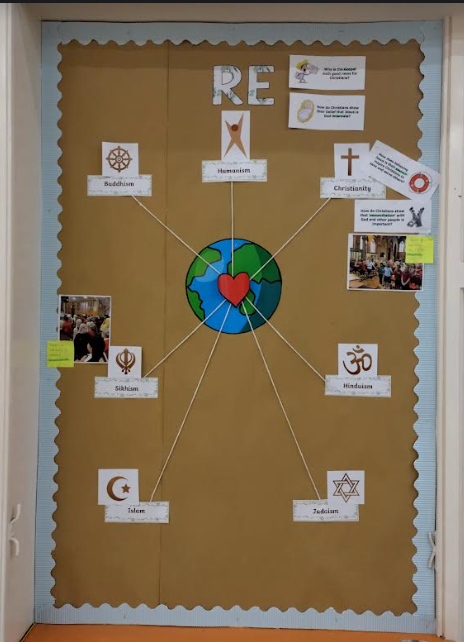RELIGIOUS EDUCATION
WHAT IS THE INTENT OF THE re CURRICULUM AT SPRINGFIELD?

Religious Education teaching at Springfield is more than labelling pews and places of worship. Instead, we use an approach that enables learners to understand what drives people of faith to live the way they do. This builds each child’s ‘religious literacy’ helping them understand the nature of religion and belief in the world in which they live. We ensure that children have fun with the subject, are immersed in art, music and stories that help them learn substantive knowledge about the 'big six' world views while ensuring equal access to a varied range of disciplinary learning experiences for pupils to write about, debate and interpret the learning.
The word 'Religion' has Latin roots that mean to bind. Our RE curriculum helps pupils to understand how text, stories, art, music, traditions, belief and learning bind our communities together. Our sequenced, accumulative curriculum supports personal development by promoting philosophy, acceptance, empathy and diversity as well as the development of transferable skills such as communication, oracy, reflection and creativity among many more.
At Springfield, we are passionate about RE and continually improving our offer. Please see our RE action plan below outlining our current development priorities.
How is re taught (implementation)
RE is taught by class teachers in a weekly block at least half termly or six times a year. Staff deliver the curriculum with the support of the Emmanuel Project which was created by the Diocese of St Edmundsbury and Ipswich. This provides Springfield with a high quality, consistent, sequenced whole school and enquiry-based approach.
The Emmanuel Project uses big questions. These questions are then explored in different ways. This is not ‘enquiry’ in the traditional sense of pupils setting and exploring their own learning. However, pupils are encouraged to ask their own questions throughout. Pupils then have the opportunity to learn from this religious belief, e.g. reconciliation, and put this into practice in their own lives.
Within each unit's big question, the children explore a religious key concept through the following areas:
(i) Text or Narrative
(ii) Community Practice
(iii) Living
This teaching and learning approach enables learners to look first at a religious text before moving on to looking at the impact of this concept on the religious community.


As part of the planning and preparation for the delivery of each unit, teachers consider how specific activities or the delivery may need to be adjusted to ensure that pupils with SEND are able to access the materials and participate fully in the lesson. Pupils with language and communication difficulties (including those with ASD) may need additional visual prompts to help them understand what is expected of them.
For more information, please have a look at our long-term plan, an introduction to the Emmanuel Project as well as a complete list of units we cover attached at the bottom of the page.
how do we measure the impact of our re curriculum?
Formative and termly summative assessments are made by the class teachers to create a data picture which determines the successful teaching and learning in RE. Additional processes including pupil book studies, lesson observations as well as discussions with staff and planning scrutinies allow the subject leader to have a broader picture of provision across the school. These opportunities to measure impact are used to inform future planning, teaching and assessment as well as targeted support for teachers and whole school CPD opportunities.
Additionally, there are a number of holistic examples of the positive impact our RE curriculum has on our students:
- Development of speaking and listening skills
- Space to develop a sense of self/identity
- Understanding of kindness, acceptance and unity
